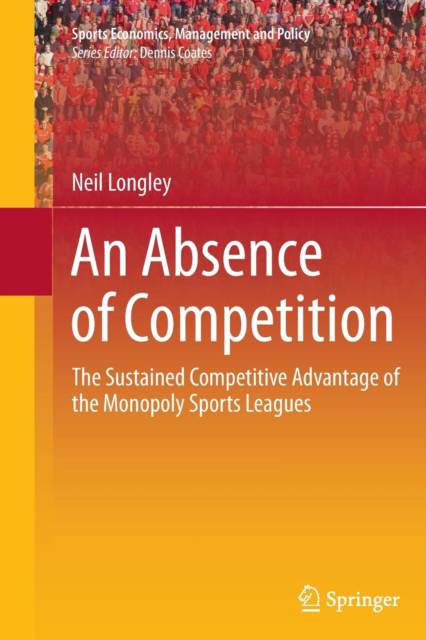
En raison d'une grêve chez bpost, votre commande pourrait être retardée. Vous avez besoin d’un livre rapidement ? Nos magasins vous accueillent à bras ouverts !
- Retrait gratuit dans votre magasin Club
- 7.000.000 titres dans notre catalogue
- Payer en toute sécurité
- Toujours un magasin près de chez vous
En raison de la grêve chez bpost, votre commande pourrait être retardée. Vous avez besoin d’un livre rapidement ? Nos magasins vous accueillent à bras ouverts !
- Retrait gratuit dans votre magasin Club
- 7.000.0000 titres dans notre catalogue
- Payer en toute sécurité
- Toujours un magasin près de chez vous
An Absence of Competition
The Sustained Competitive Advantage of the Monopoly Sports Leagues
Neil Longley
183,45 €
+ 366 points
Format
Description
This book takes a multi-disciplinary approach to analyzing the nature of 'competition' and 'competitive advantage' within the U.S. pro sport industry. By many measures, the four major pro sports leagues in the U.S. - the National Football League (NFL), National Basketball Association (NBA), National Hockey League (NHL), and Major League Baseball (MLB) - are now some of the most successful business entities in the country. While these established leagues have generally been highly profitable throughout their respective existences, the past two decades have been particularly lucrative, with franchise values in all four leagues growing rapidly, and at levels well beyond market rates of return. Within this context, the book seeks to explore the nature of the competitive advantage that these leagues apparently possess. The purpose is to identify not only how these leagues have been able to get to where they are today, but also to examine the competitive threats and opportunities that these leagues face as they move forward. A key contribution of the book is that it analyzes these issues from a multi-disciplinary approach including a traditional economics perspective, public policy and public choice theory and strategic management, to provide a parallel explanation for the success of each of the four major leagues. It argues that no single conceptual approach can, in itself, adequately explain the full richness of the issue. Its stresses that these various approaches should generally be viewed as complements, rather than as being mutually exclusive, and that a full understanding of the issue requires one to adopt a multi-disciplinary perspective, making it of interest to scholars in strategic management, sport management, and economics. It can serve as an effective teaching tool in both graduate and upper-level undergraduate courses for students in these fields, and is particularly useful for faculties seeking to emphasize to their students theimportance of a multi-disciplinary, integrative, approach when analyzing business and management issues. The book may also be of interest to leaders within the sport industry itself, and will help to provide insight and perspective as leagues seek to enhance their competitive advantage in the marketplace.
Spécifications
Parties prenantes
- Auteur(s) :
- Editeur:
Contenu
- Nombre de pages :
- 119
- Langue:
- Anglais
- Collection :
- Tome:
- n° 5
Caractéristiques
- EAN:
- 9781493943357
- Date de parution :
- 27-08-16
- Format:
- Livre broché
- Format numérique:
- Trade paperback (VS)
- Dimensions :
- 156 mm x 234 mm
- Poids :
- 199 g

Les avis
Nous publions uniquement les avis qui respectent les conditions requises. Consultez nos conditions pour les avis.






